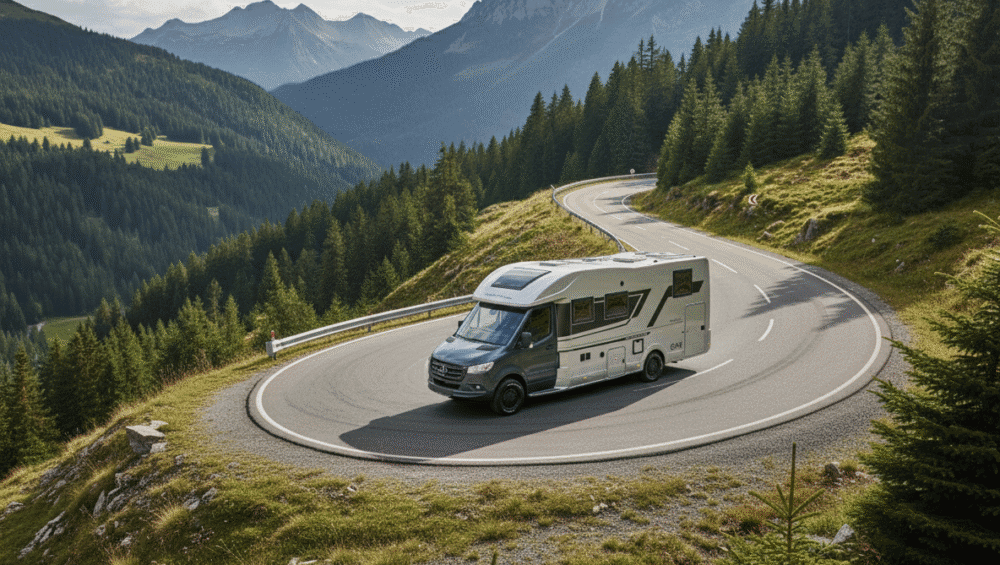If your motorhome feels a bit bouncy on rough roads, sags at the back when loaded or struggles to stay level on uneven ground, you’re not alone. Many owners experience these issues- especially with heavier or older vehicles.
That’s where rear air suspension comes in. It’s one of the most popular upgrades for improving ride comfort, stability and control in a motorhome. In this guide, we’ll walk you through everything you need to know: what it is, how it works, the benefits, costs and whether it’s right for your setup.
What Is Rear Air Suspension?
Rear air suspension is a system that uses inflatable air bags (air springs) instead of, or alongside traditional metal leaf springs, to support your motorhome’s rear axle.
The pressure in these air bags can be adjusted manually or automatically, helping you level your motorhome, improve ride comfort and maintain the correct ride height regardless of how much weight you’re carrying.
Think of it as a cushion of air between your chassis and the road: flexible, smooth and adaptable.
How Does Rear Air Suspension Work?
The system typically includes:
- Air bags / air bellows: Mounted between the chassis and axle to support the vehicle.
- Compressor and control system: Inflates or deflates the bags to adjust pressure.
- Valves and airlines: Carry air from the compressor to each airbag.
- Pressure gauges / switches: Allow you to manually control pressure or view levels from inside the cab.
Some setups can be more manual (via Schrader valves), while more advanced systems are semi-automatic or fully automatic, adjusting pressure dynamically based on load and road conditions.
Benefits of Rear Air Suspension for Motorhomes
1. Improved Stability and Handling
Rear air suspension helps reduce body roll, sway and bounce- particularly noticeable on winding roads, when overtaken by lorries or in strong crosswinds.
2. Level Ride Height
A heavy rear garage or bike rack can cause the back of your motorhome to sag. Air suspension restores the correct ride height, improving braking efficiency and ground clearance.
3. Comfortable Ride
The adjustable air cushion absorbs shocks more effectively than metal springs, giving you and your passengers a noticeably smoother ride.
4. Reduced Wear and Tear
By evenly distributing load, air suspension minimises strain on the chassis, tyres and existing suspension components- helping extend their lifespan.
5. Easier Levelling on Site
Many systems allow you to fine-tune height side-to-side, helping you level your motorhome quickly when parked- perfect for uneven pitches.
6. Better Towing and Load Support
If you tow a car, trailer or carry heavy gear (like scooters or e-bikes), air suspension helps stabilise the rear end and improves traction.
Types of Rear Air Suspension Systems
There are two main types:
Single Airbag System
A basic, cost-effective option that adds air support alongside existing leaf springs. Ideal for smaller or medium-weight motorhomes.
Twin Airbag System
A more advanced system with separate control of left and right sides. Perfect for larger, heavier vehicles or those carrying uneven loads.
Optional upgrades include:
- Onboard compressor kits for easy inflation.
- Dash-mounted pressure gauges.
- Automatic levelling systems.
Costs and Installation
- Basic (manual) systems: from around £1,000–£1,500 fitted
- Fully adjustable / compressor kits: from £1,800–£2,500+ fitted
Prices vary based on your chassis type (Fiat Ducato, Peugeot Boxer, Mercedes Sprinter, etc.), brand ( Al-Ko, VB Air Suspension, Dunlop, Drive-Rite) and workshop labour.
Always choose an NCC Approved Workshop or specialist fitter because poor installation can lead to leaks or handling issues.
Maintenance and Servicing
Rear air suspension systems are relatively low-maintenance but benefit from some regular checks:
✅ Inspect airbags for cracks or leaks.
✅ Check airlines and fittings for wear or rubbing.
✅ Ensure compressor filters and valves are clean.
✅ Monitor pressure before every long trip.
✅ Have a professional inspection annually, ideally during your habitation service.
Catching small issues early (like a slow air leak) prevents more expensive repairs later.
Common Questions About Rear Air Suspension
1. Is it worth upgrading to rear air suspension?
If your motorhome feels unstable, sags under load, or you carry lots of gear, absolutely. It’s one of the most noticeable upgrades you can make for comfort and control.
2. Can I adjust it myself?
Yes, most systems allow manual pressure adjustment. For added convenience, consider an onboard compressor system with in-cab controls.
3. Does it affect warranty or MOT?
When installed correctly by an approved specialist, it shouldn’t. Always inform your insurer and keep documentation.
4. Will it make my motorhome higher?
Slightly but only by a few centimetres when inflated to normal pressures. The benefit is adjustable ride height when needed.
5. Does air suspension replace or work with my existing springs?
Most retrofit systems work alongside your existing leaf springs, providing extra support rather than replacing them completely.
Pros and Cons at a Glance
| Pros | Cons |
|---|---|
| Better comfort and handling | Higher upfront cost |
| Adjustable ride height | Needs professional fitting |
| Improved stability | Minor ongoing maintenance |
| Reduces wear on suspension | Slightly more complex system |
Final Thoughts
Rear air suspension isn’t just a luxury upgrade- it’s a smart investment in comfort, safety and long-term value. Whether you’re tackling long European road trips or carrying heavy loads on weekends away, the difference in ride quality and stability is immediate.
If you’re considering fitting or upgrading your system, always use a trusted, experienced workshop familiar with your chassis type.
Thinking about upgrading your motorhome suspension?
At Bristol Caravans & Motorhomes, we supply and install a full range of rear air suspension systems, from simple manual kits to advanced fully adjustable setups- all fitted to NCC Approved standards.
📞 Call 01454 612 893 to discuss the best option for your motorhome.




